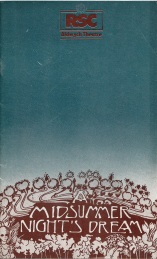
The other night I was watching Greg Doran, Artistic Director of the Royal Shakespeare Company, giving the annual Richard Dimbleby Lecture on TV. Let me say straight away that if you missed it I’d head over to BBC I Player and catch up with what is a most informative and entertaining 45 minutes. Greg spoke about how, at the age of eight, he had first encountered A Midsummer Night’s Dream on an old 45 rpm record belonging to his father and which contained Mendelssohn’s famous music interspersed with speeches from the play. Although he confessed Puck’s voice reminded him of Mickey Mouse he was captivated. As I have observed before The Dream is many people’s “way in” to the Bard and it was instructive that it seemed to be no different for the head of the preeminent Shakespearean organisation in the UK today. It also set me thinking about how the RSC had approached this most perennial and well-loved play over the years up until its present incarnation as A Midsummer Night’s Dream: A Play For The Nation.
The history of playing Shakespeare as a major and revered playwright in Stratford upon Avon can be traced back at least as far as 1769 when the celebrated actor David Garrick mounted a three day Jubilee festival. Unfortunately it was literally a wash out as first the Avon burst its banks and then a grand pageant was cancelled because of torrential rain. Nevertheless it set the seal on the town becoming the centre for all things Shakespeare (more here). By 1879 the first Shakespeare Memorial Theatre had been completed. After this burnt down a replacement was constructed, opening in 1932; the façade is the one we still see today. In 1961, under Peter Hall’s stewardship, the birth of the Royal Shakespeare Company took place and its chief venue became known as The Royal Shakespeare Theatre. Since that time A Midsummer Night’s Dream has been tackled on numerous occasions.
The first of these was Peter Hall’s production in 1962 which was a revival of his own 1959 version. This had starred Charles Laughton as Bottom; this time round the cast contained a couple of relatively unknown young ladies – Judi Dench and Diana Rigg as Titania and Helena respectively. (Interesting fact: Dame Judi currently holds the record for the most performances of Titania on the UK stage having played the role several times in her career).

The next version in 1970 proved to be one of the most influential versions of any Shakespeare play – ever. This was Peter Brook’s famously radical production which mixed circus and acrobatic skills with the original language and which took place in a stark white box. Famous names in this one were Alan Howard (Oberon/Theseus), Frances de la Tour (Helena) and Ben Kingsley (Demetrius). Unfortunately I was just a bit too young to have seen it – though I have seen filmed clips of it since – but it has long passed into theatrical legend. The tale of this production has been well told over the decades but if you would like further information please click here.

I’ll mention John Barton’s production of 1977 if only because it was the first time I saw the play being performed by the RSC. I’d become a regular RSC goer during my student years (what with the then generous discounts) and looking back it must have been a hard act to follow Brook’s version which preceded it. Heavily influenced by the darker side of the famous Arthur Rackham illustrations I remember the fairies as being particularly unsettling and that there was a loin clothed Patrick Stewart as Oberon. It was also the first time I saw an actor I went on to very much admire – the late great Richard Griffiths as Bottom.
Just in case you’re wondering whether I’m going to outline every single production then you may be relieved to hear that the answer is no. Instead here’s a table of the subsequent RSC productions (which makes it easier to bypass if you’re so inclined).
Year |
Director |
In the cast |
Remarks |
1981 |
Ron Daniels |
Juliet Stevenson: Titania/HippolytaHarriet Walter: Helena |
Victorian toy theatre setting |
1986 |
Bill Alexander |
David Haig: QuincePete Postlethwaite: BottomSean Bean: Starveling |
The Art Deco design was by William Dudley who used to be a Tower Theatre member |
1989 |
John Caird |
Claire Higgins: TitaniaDavid Troughton: Bottom |
Set in a junkyard with punk fairies. More here |
1994 |
Adrian Noble |
Alex Jennings: Oberon/TheseusToby Stephens: Lysander |
Surrealist shifting landscape |
1999 |
Michael Boyd |
Josette Simon: Titania/Hippolyta |
Wintry court v. summery forest.Designed by Tom Piper who is the designer of the current production |
2002 |
Richard Jones |
Dominic Cooper: Puck |
Gothic sex and horror – not all that well received |
2005 |
Greg Doran |
Malcolm Storry: BottomJonathan Slinger: Puck |
Non-specific modern setting. Revived 2008. More here |
2006 |
Tim Supple |
Ajay Kumar: PuckArchana Ramaswamy: Titania |
Toured India first. Spoken in English and six Indian languages. More here |
2011 |
Nancy Meckler |
Pippa Nixon: TitaniaMarc Wooton: Bottom |
Dark beginnings but transforming to late 60s summer of love. More here |
And so to the current (our) production which is probably the most ambitious yet and certainly involves a much larger cast of actors and set of creatives than has ever gone before. So why is the RSC doing it again? Indeed why is it done quite so often (there are at least four high profile productions in the capital in the first six months of this year)? Well, it is an extremely well-constructed play interweaving three worlds (the court, the Mechanicals and the fairies); the plots in these various strands are all brought to a satisfactory and peaceful resolution giving it a high feel good factor. It has some cracking roles for actors and actresses. It is reliably funny but at the same time has something serious to say about relationships and the nature of love. Perhaps, above all, it appeals to children and the child within us all. So it is an excellent choice through which the RSC can demonstrate its prowess and which one which will have a wide based appeal.
The RSC sets the bar very high indeed; just look at some of the numbers in this video
Pretty impressive I think you’ll agree. Now in this memorial year it seems only right and proper for the company to be tackling one of Shakespeare’s key texts and one that, as the above has hopefully shown, can be interpreted and reinterpreted in a number of ways and for different generations. The touring concept of the production will bring in many new audience members and its inclusive nature (using amateurs and schoolchildren) truly makes it “A Play For The Nation”. So what, if it’s been done a dozen times since the RSC came into being. Hold on – a dozen? That means we’re the 13th production doesn’t it? Just as well we actors aren’t a superstitious bunch, eh?
The UK tour continues this week at Northern Stage in Newcastle. Please click on image below to show details







[…] MND at the RSC March 22, 2016 […]
LikeLike
[…] centuries. Dreamwise there was a recreation of the white box set from the celebrated Peter Brook version of the 1970s. This exhibit also had photos, costumes and even props from the production. As usual […]
LikeLike